In Search of the Elusive Thin Legged Katydid
|
||||||||||||
| Printer Friendly Story View |
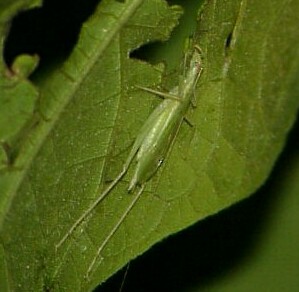
I probably looked strange that night, standing on a 12-foot stepladder, head lost in the leaves of a large catalpa tree next to the street, camera in one hand, flashlight in the other. It didn't matter; I was on the trail of an elusive sound that had intrigued me for years.
I've always been curious about the natural world. I majored in biology in college and might have ended up in that field had I not found computers and my destiny. Still, I love to walk, and look, and listen to the interesting animal life that's all around us, and so often overlooked.
As a kid in Louisiana, there was plenty to look at. I caught snakes, kept lizards in cages, went through the insect collecting phase. Later I got into photography and invested in close-up gear. I have a great color slide collection of mushrooms, including some of the smallest you'll ever see.
Nighttime in south Louisiana, where my grand parents lived, always brought a symphony of sounds. Not just crickets, but a wide range of insects, frogs, flying squirrels, owls and the like.
What intrigued me the most was what the old folks called "tree frogs". The sound was not very frog-like. And, although I found some tiny frogs, I never found a frog in a tree making the sound attributed to them.
Over the years I learned that most of the sounds I loved were, in fact, insects. Many were probably varieties of katydids, of which there are over 4,000 species worldwide. Katydids, like crickets, make a sound by rubbing the barbed front edge of their wings against each other. They do it so fast that it's just a blur and the sound can take many forms.
Many predators seek katydids out so they have developed great strategies for hiding. Some mimic leaves, others are like twigs. They blend in and sit still. Although their calls can be very loud, they bounce off leaves and are hard to locate.
So back to that catalpa tree and my step ladder.
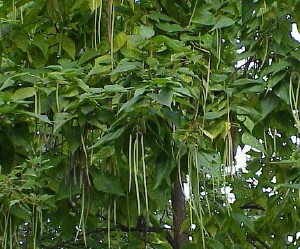 For several years I've noticed an insect calling in the mid-summer evenings and it was one I could not identify. The sounds would start about dusk and continue until about mid-night. Walking around it was obvious the sounds were coming from our catalpa tree. It was loud enough to hear from a half block away, and walking the neighborhood, I didn't hear it near any other trees.
For several years I've noticed an insect calling in the mid-summer evenings and it was one I could not identify. The sounds would start about dusk and continue until about mid-night. Walking around it was obvious the sounds were coming from our catalpa tree. It was loud enough to hear from a half block away, and walking the neighborhood, I didn't hear it near any other trees.Loud as the sound was, and try as I might, I could never find the source. Each time I moved, the sound would move. The dense catalpa leaves are some of the largest found in Michigan, and they were reflecting the sound.
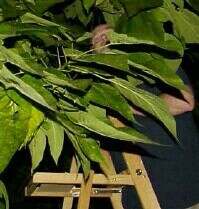 After summers of casual searching for the source of the elusive sound, this year I got serious. Every night for a week I went out with a flashlight and spent long sessions under the tree searching.Finally I drug out the big stepladder and got my head right up into the tree. Night after night I embarrassed the family by spending time in the tree.
After summers of casual searching for the source of the elusive sound, this year I got serious. Every night for a week I went out with a flashlight and spent long sessions under the tree searching.Finally I drug out the big stepladder and got my head right up into the tree. Night after night I embarrassed the family by spending time in the tree. It was very frustrating. I'd move, the sound would move. If I moved the leaves in an area the sound would stop. I found plenty of spiders, watched a large moth laying eggs under a leaf, fed many mosquitoes, and came close to falling off the ladder more than once.
But I persisted, and I succeeded!
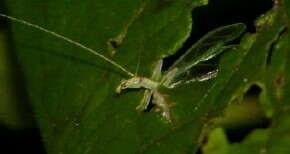 There it was; a long slender katydid sticking through a hole in a leaf. Its wings were extended in line with the leaf and the body went right through the hole! The wings would vibrate in a blur and there was the sound. No mistake!
There it was; a long slender katydid sticking through a hole in a leaf. Its wings were extended in line with the leaf and the body went right through the hole! The wings would vibrate in a blur and there was the sound. No mistake!As I moved for a better look, I brushed the leaf and the katydid immediately pulled back and hugged flat to the leaf. The color of leaf and bug were almost identical. No wonder they were so hard to find. But now I knew what to look for.
Over the next few nights I was able to find half a dozen of the critters and watch their fascinating behavior. Hide under the leaf. Climb into the hole to sing. I can't be sure if they cut the holes in the leaf, but there are lots of holes and that's the place I found the insect singing! The only exception was when a second katydid showed up near the one I was watching. They faced off on the underside of the leaf, wings standing straight up, and sang to each other. (Both male and female katydids sing, so perhaps this was courtship!) Outside of the hole, the sound was not nearly as loud. The leaf seemed to act like sound board and amplified the song!
So one mystery is solved. The other mystery is to identify the species. Searching the web I found a picture that looked just like this one and was identified as a "thin legged katydid". But it was more brownish in color and said to be found in the desert southwest. Not much desert here, but they sure looked alike! So until someone tells me otherwise, or I get to the library, I've found my elusive bug and I'm calling it a "thin legged katydid".
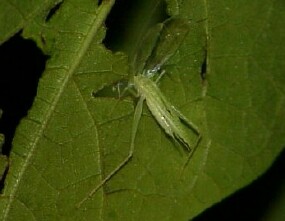 | 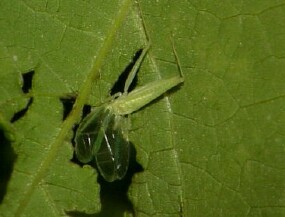 |
| Printer Friendly Story View |
|
|

Stephen Kent |
|
|
|
Printer-Friendly Story View
0200 Nd: 04-12-2024 d 4 cpr 0
12/31/2020 P3v3-0200-Ad.cfm
SPONSORED LINKS
12/31/2020 drop ads P3v3-0200-Ad.cfm


